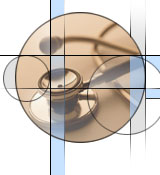





Epidemiology
There are between 5-15 primary brain tumours per 100,000 population. This accounts for 5-10% of all cancers in all age groups and probably 30-40% of tumours in children. Tumours may also spread to the brain from distant sites (secondary tumour). The commonest tumours which spread to the brain are lung (44%), breast (10%), kidney (7%), bowel (6%), melanoma (3%) and 10% are from an unknown source. Brain tumours themselves almost never spread out from the central nervous system.
Presentation
Tumours usually present in one of three ways: headaches (54%), progressive neurological deficit (68%) or seizures (26%).
The headaches are related to raised pressure inside the brain. The classical description is one of early morning headaches, often over the forehead, which is present when the person wakes up. The headache usually settles by afternoon. Many patients also complain of nausea or vomiting.
Any neurological deficit will depend on the site of the tumour. The commonest deficit seen is a weakness (frontal tumour), some patients may have numbness (parietal tumour), problems with speech (dominant temporal tumours), visual problems (temporal, parietal or occipital tumour) or a change in personality (frontal tumour). Certain tumours present in a very specific fashion, i.e. endocrine problems with a pituitary tumour.
Seizures (epileptic fits) occurring for the first time in an adult must be investigated with an urgent scan. The types in fits seen in patients with tumours varies from classical grand mal seizures where the patient loses consciousness, shakes, may be incontinent and tongue bites, to focal seizures which may cause a temporary loss of function. In patients with a tumour in the movement area they may lose movement in one arm for a short period of time which then spontaneously recovers.
ASTROCYTOMA

Grading of Astrocytomas
These tumours are graded in various ways and the grading reflects the prognosis and survival form each individual tumour. The type of tumour is confirmed by assessing any biopsy specimens under the microscope (histology). The grade is also established by assess the tumour histologically, looking for dividing cells, invasion of blood vessels and necrosis (cell death).
| WHO Grade | Treatment Options | Mean Survival | |
| 0 | Pilocytic Astrocytoma | Surgical Excision | Possible Cure |
| 1 | Low Grade Astrocytoma | No treatment with serial scans only Biopsy/Excision Radiotherapy and/or Chemotherapy | 8-10 years |
| 2 | Low Grade Astrocytoma | No treatment with serial scans only Biopsy/Excision Radiotherapy and/or Chemotherapy | 7-8 years |
| 3 | Anaplastic Astrocytoma | No treatment Biospy/Debulking (reduce volume of tumour) Radiotherapy Chemotherapy | 2 years |
| 4 | Glioblastoma Multiforme | No treatment Biospy/Debulking (reduce volume of tumour) Radiotherapy Chemotherapy | < 1 year |

Treatment Options
The treatment of brain tumours depends on many variables. The location, size and extent of the tumour will often determine which treatment may be most beneficial. Younger patients and those who are generally well (self caring) have a better outcome than older patients or those who have neurological deficits.
There are no hard and fast rules to the treatment of these tumours and each patient's treatment is individually tailored to his or her needs. The rationale for surgery may vary from one patient to another, as may the sue of radiotherapy or chemotherapy.
There are no cures for astrocytomas (other than some pilocytic tumours), however a combination of surgery, radiotherapy and chemotherapy may increase survival in some instances. The aim of any treatment must be to improve quality of survival.
Surgery
The role of surgery may be diagnostic or therapeutic. Some patients may not be suitable for surgery.
The location and extent of a tumour may make it unsuitable for a debulking, in which case a biopsy may be proformed to confirm the diagnosis. A biopsy removes a small piece of the tumour so it may be examined under the microscope.
The options for a biopsy are:
- To make a hole in the skull and take a piece of the tumour free-hand.
- To locate the tumour using an image guidance system and take a piece.
- Stereotactically locate the tumour and preform a biopsy using a fixed frame.


If the tumour is in a relatively "silent" part of the brain or if it so large that it is causing symptoms or raised pressure in the brain, it may be debulked. The aim is to safely reduce the volume of the tumour. A craniotomy is perfromed, either free hand, with image guidance or with the help of the stereotactic frame. Tumour spread in such a way that they cannot be cured by simply removing them. All patients MUST be referred for an oncological opinion to a neuro-oncologist.
The neuro-oncologist will decide on whether radiotherapy, chemotherapy or palliation is the most appropriate option.
